Analysis of Diesel Knock for High-Altitude Heavy-Duty Engines Using Optical Rapid Compression Machines
Abstract
1. Introduction
2. Experimental Setup and Methodology
2.1. Experimental Setup
2.2. Test Operation Conditions
3. Results and Discussion
3.1. Effects of Fuel Injection Pressure
3.2. Effects of Ambient Pressure
3.2.1. Critical Conditions
3.2.2. Knocking Conditions
3.3. Analysis of Pressure Oscillation
4. Conclusions
Supplementary Materials
Author Contributions
Funding
Conflicts of Interest
References
- Kan, Z.; Hu, Z.; Lou, D.; Tan, P.; Cao, Z.; Yang, Z. Effects of altitude on combustion and ignition characteristics of speed-up period during cold start in a diesel engine. Energy 2018, 150, 164–175. [Google Scholar] [CrossRef]
- Wang, X.; Ge, Y.; Yu, L.; Feng, X. Comparison of combustion characteristics and brake thermal efficiency of a heavy-duty diesel engine fueled with diesel and biodiesel at high altitude. Fuel 2013, 107, 852–858. [Google Scholar] [CrossRef]
- Shen, L.; Shen, Y.; Yan, W.; Xu, J. Combustion process of diesel engines at regions with different altitude. SAE Tech. Pap. 1995. [Google Scholar] [CrossRef]
- Meininger, R.D.; Kweon, C.-B.M.; Szedlmayer, M.T.; Dang, K.Q.; Jackson, N.B.; Lindsey, C.A.; Gibson, J.A.; Armstrong, R.H. Armstrong, Knock criteria for aviation diesel engines. Int. J. Engine Res. 2016, 18, 752–762. [Google Scholar] [CrossRef]
- Heywood, J. Internal Combustion Engine Fundamentals; McGraw-Hill Education: New York, NY, USA, 1988. [Google Scholar]
- Syrimis, M.; Assanis, D. Knocking cylinder pressure data characteristics in a spark-ignition engine. J. Eng. Gas Turbines Power 2003, 125, 494–499. [Google Scholar] [CrossRef]
- Ren, Y.; Randall, R.; Milton, B. Influence of the resonant frequency on the control of knock in diesel engines. Proc. Inst. Mech. Eng. D 1999, 213, 127–133. [Google Scholar] [CrossRef]
- Hickling, R.; Feldmaier, D.; Sung, S. Knock-induced cavity resonances in open chamber diesel engines. Acoust. Soc. Am. 1979, 65, 1474–1479. [Google Scholar] [CrossRef]
- Rusly, A.; Kook, S.; Hawkes, E.; Zhang, R. High-speed imaging of soot luminosity and spectral analysis of in-cylinder pressure trace during diesel knock. SAE Tech. Pap. 2014. [Google Scholar] [CrossRef]
- Zhao, M.; Kaiser, S. Optical Diagnostics for Knock in Compression-Ignition Engines via High-Speed Imaging. SAE Int. J. Engines 2018, 11, 903–918. [Google Scholar] [CrossRef]
- Pan, J.; Hu, Z.; Wei, H.; Pan, M.; Liang, X.; Shu, G.; Zhou, L. Understanding strong knocking mechanism through high-strength optical rapid compression machines. Combust. Flame 2019, 202, 1–15. [Google Scholar] [CrossRef]
- Qi, Y.; Wang, Z.; Wang, J.; He, X. Effects of thermodynamic conditions on the end gas combustion mode associated with engine knock. Combust. Flame 2015, 162, 4119–4128. [Google Scholar] [CrossRef]
- Wang, Z.; Qi, Y.; He, X.; Wang, J.; Shuai, S.; Law, C.K. Analysis of pre-ignition to super-knock: Hotspot-induced deflagration to detonation. Fuel 2015, 144, 222–227. [Google Scholar] [CrossRef]
- Kawahara, N.; Tomita, E.; Sakata, Y. Auto-ignited kernels during knocking combustion in a spark-ignition engine. Proc. Combust. Inst. 2007, 31, 2999–3006. [Google Scholar] [CrossRef]
- Agarwal, A.K.; Dhar, A.; Gupta, J.G.; Kim, K.; Choi, W.I.; Lee, C.S.; Park, S. Effect of fuel injection pressure and injection timing of Karanja biodiesel blends on fuel spray, engine performance, emissions and combustion characteristics. Energy Convers. Manag. 2015, 91, 302–314. [Google Scholar] [CrossRef]
- Liu, F.; Yang, Z.; Li, Y.; Wu, H. Experimental study on the combustion characteristics of impinging diesel spray at low temperature environment. Appl. Therm. Eng. 2019, 148, 1233–1245. [Google Scholar] [CrossRef]
- Agarwal, A.K.; Dhar, A.; Gupta, J.G.; Kim, W.I.; Lee, C.S.; Park, S. Effect of fuel injection pressure and injection timing on spray characteristics and particulate size–number distribution in a biodiesel fuelled common rail direct injection diesel engine. Appl. Energy 2014, 130, 212–221. [Google Scholar] [CrossRef]
- Martin, G.C.; Mueller, C.J.; Milam, D.M.; Radovanovic, M.S.; Gehrke, C.R. Early direct-injection, low-temperature combustion of diesel fuel in an optical engine utilizing a 15-hole, dual-row, narrow-included-angle nozzle. SAE Int. J. Engines 2009, 1, 1057–1082. [Google Scholar] [CrossRef]
- Du, W.; Zhang, Q.; Zhang, Z.; Lou, J.; Bao, W. Effects of injection pressure on ignition and combustion characteristics of impinging diesel spray. Appl. Energy 2018, 226, 1163–1168. [Google Scholar] [CrossRef]
- Khalid, A. Effect of ambient temperature and oxygen concentration on ignition and combustion process of diesel spray. Asian J. Sci. Res. 2013, 6, 434–444. [Google Scholar] [CrossRef]
- Jaat, M.; Khalid, A.; Sapit, A.; Basharie, S.M.; Andsaler, A.R.; Ramsy, H. Effects of temperature and ambient pressure on spray characteristics of biodiesel combustion. Appl. Mech. Mater. 2015, 773, 501–505. [Google Scholar] [CrossRef]
- Jain, A.; Singh, A.P.; Agarwal, A.K. Effect of fuel injection parameters on combustion stability and emissions of a mineral diesel fueled partially premixed charge compression ignition (PCCI) engine. Appl. Energy 2017, 190, 658–669. [Google Scholar] [CrossRef]
- Kyrtatos, P.; Hoyer, K.; Obrecht, P.; Boulouchos, K. Apparent effects of in-cylinder pressure oscillations and cycle-to-cycle variability on heat release rate and soot concentration under long ignition delay conditions in diesel engines. Int. J. Engine Res. 2014, 15, 325–337. [Google Scholar] [CrossRef]
- Mittal, G.; Bhari, A. A rapid compression machine with crevice containment. Combust. Flame 2013, 160, 2975–2981. [Google Scholar] [CrossRef]
- Yu, L.; Mao, Y.; Qiu, Y.; Wang, S.; Li, H.; Tao, W.; Qian, Y.; Lu, X. Experimental and modeling study of the autoignition characteristics of commercial diesel under engine-relevant conditions. Proc. Combust. Inst. 2019, 37, 4805–4812. [Google Scholar] [CrossRef]
- Wang, X.; Ge, Y.; Yu, L.; Feng, X. Effects of altitude on the thermal efficiency of a heavy-duty diesel engine. Energy 2013, 59, 543–548. [Google Scholar] [CrossRef]
- Weber, B.W.; Sung, C.-J.; Renfro, M.W. On the uncertainty of temperature estimation in a rapid compression machine. Combust. Flame 2015, 162, 2518–2528. [Google Scholar] [CrossRef]
- Wang, Z.; Liu, H.; Song, T.; Qi, Y.; He, X.; Shuai, S.; Wang, J. Relationship between super-knock and pre-ignition. Int. J. Engine Res. 2015, 16, 166–180. [Google Scholar] [CrossRef]
- Shi, Z.; Lee, C.-F.; Wu, H.; Li, H.; Wu, Y.; Zhang, L.; Bo, Y.; Liu, F. Effect of injection pressure on the impinging spray and ignition characteristics of the heavy-duty diesel engine under low-temperature conditions. Appl. Energy 2020, 262, 114552. [Google Scholar] [CrossRef]
- Mohammadi, A.; Kidoguchi, Y.; Miwa, K. Effect of injection parameters and wall-impingement on atomization and gas entrainment processes in diesel sprays. SAE 2002, 1, 1070–1079. [Google Scholar]
- Khalid, A.; Yatsufusa, T.; Miyamoto, T.; Kawakami, J.; Kidoguchi, Y. Analysis of relation between mixture formation during ignition delay period and burning process in diesel combustion. SAE Tech. Pap. 2009. Available online: https://www.sae.org/publications/technical-papers/content/2009-32-0018/ (accessed on 13 June 2020).
- Chen, B.; Feng, L.; Wang, Y.; Ma, T.; Liu, H.; Geng, C.; Yao, M. Spray and flame characteristics of wall-impinging diesel fuel spray at different wall temperatures and ambient pressures in a constant volume combustion vessel. Fuel 2019, 235, 416–425. [Google Scholar] [CrossRef]
- Dhole, A.; Yarasu, R.; Lata, D. Investigations on the combustion duration and ignition delay period of a dual fuel diesel engine with hydrogen and producer gas as secondary fuels. Appl. Therm. Eng. 2016, 107, 524–532. [Google Scholar] [CrossRef]
- Gu, X.J.; Emerson, D.R.; Bradley, D. Modes of reaction front propagation from hot spots. Combust. Flame 2003, 133, 63–74. [Google Scholar] [CrossRef]
- Brunt, M.F.J.; Pond, C.R.; Biundo, J. Gasoline Engine Knock Analysis using Cylinder Pressure Data. SAE Tech. Pap. 1998. [Google Scholar] [CrossRef]
- Pan, J.; Shu, G.; Wei, H. Research on in-cylinder pressure oscillation characteristic during knocking combustion in spark-ignition engine. Fuel 2014, 120, 150–157. [Google Scholar] [CrossRef]
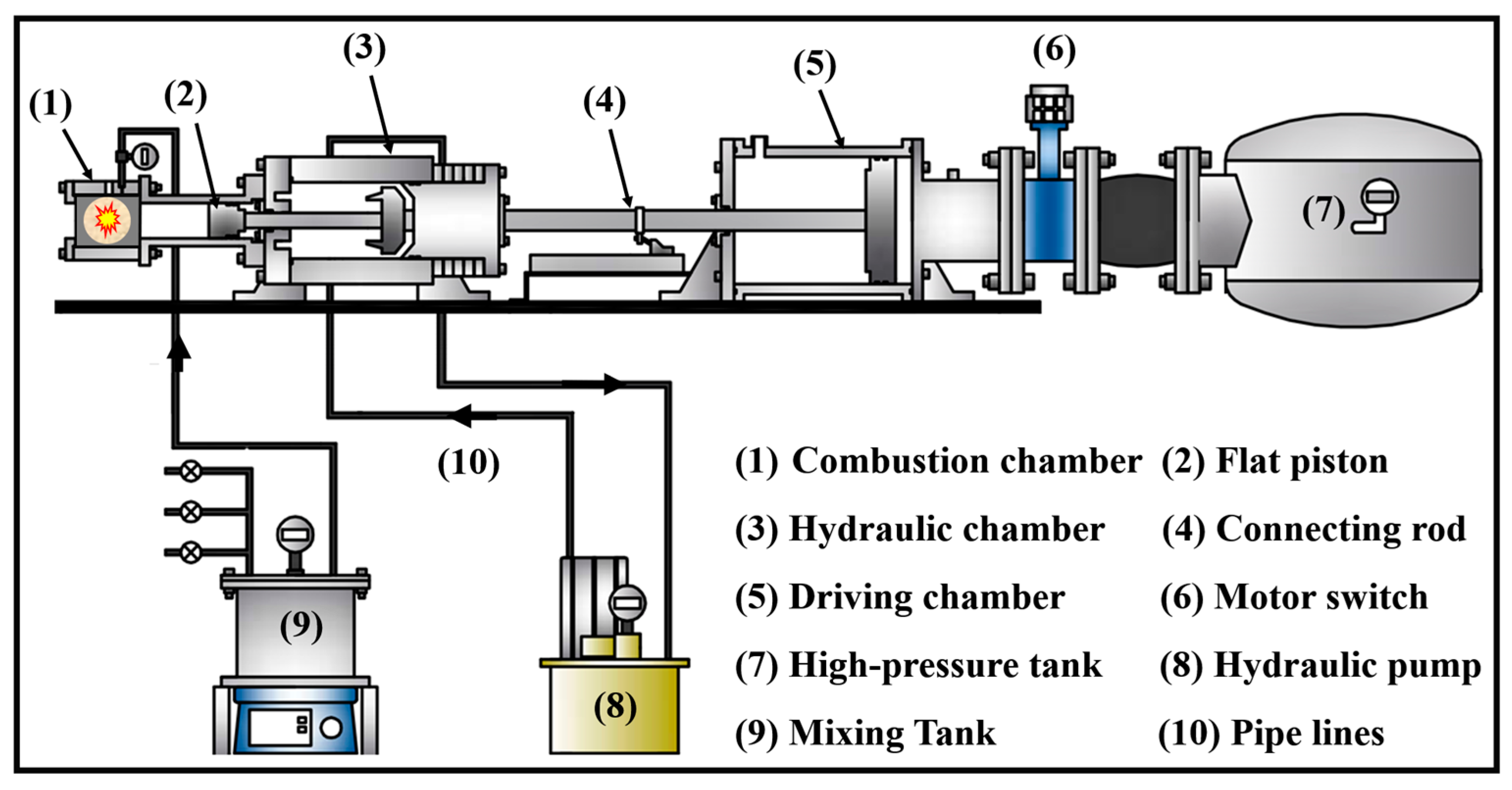

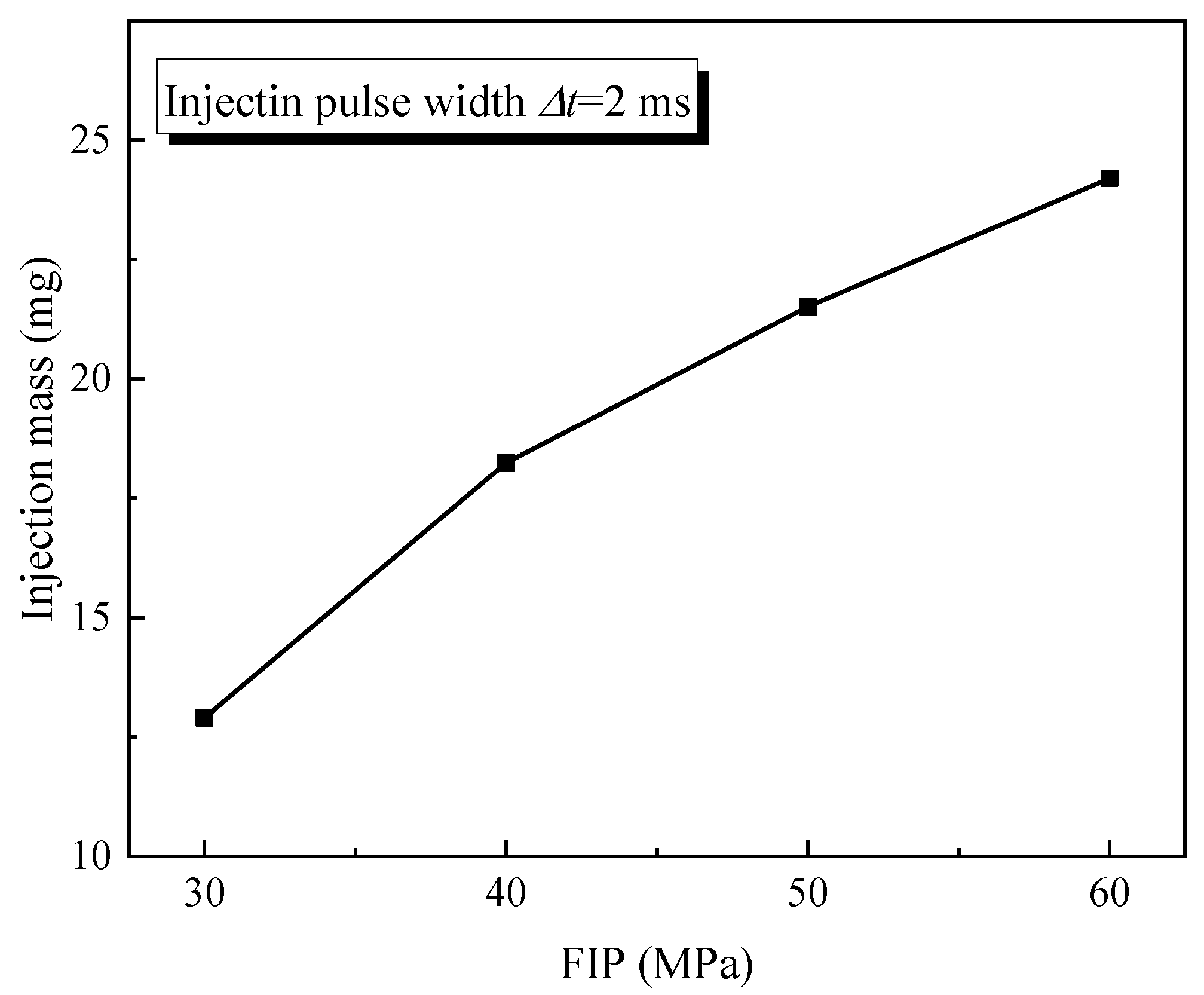

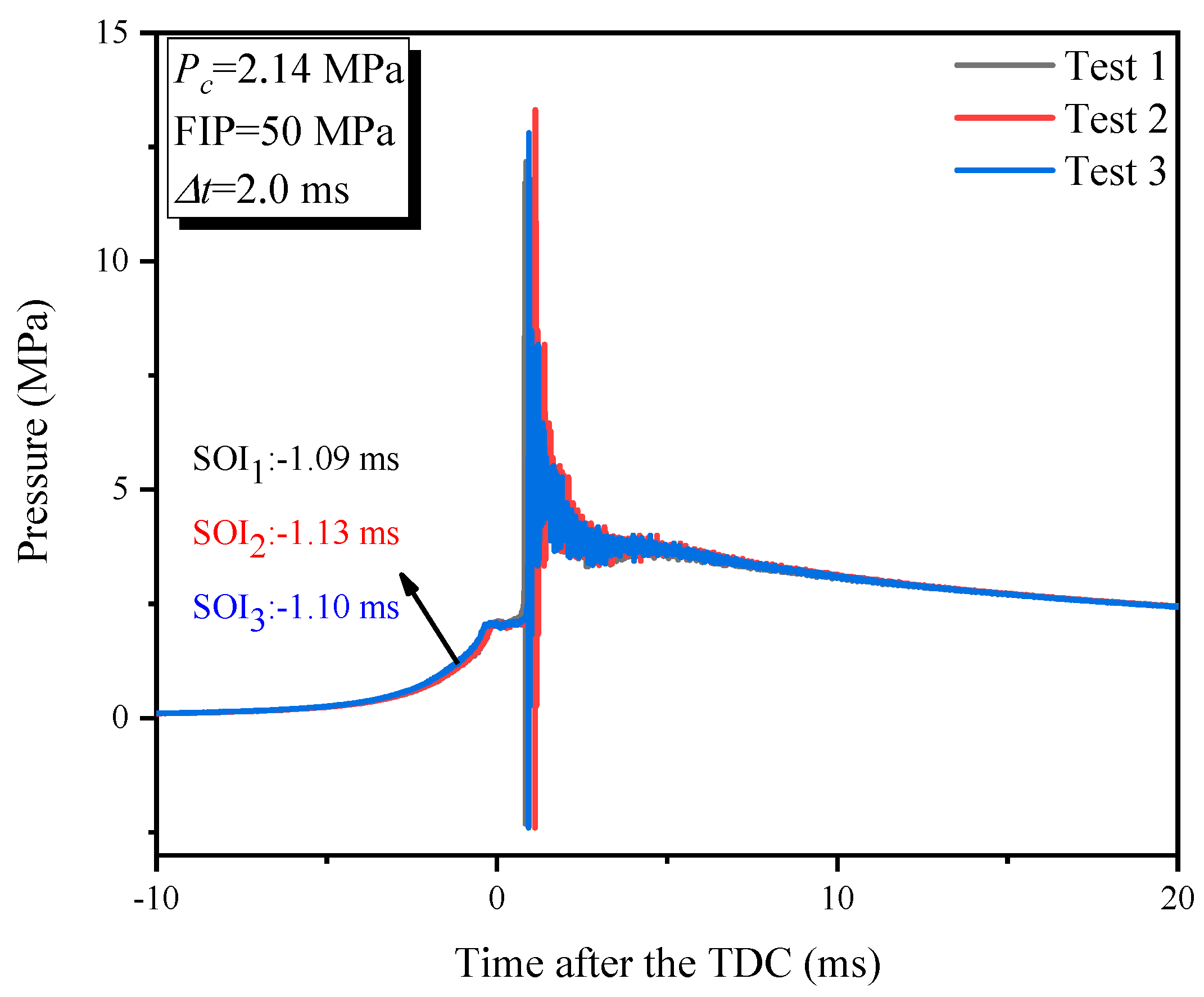
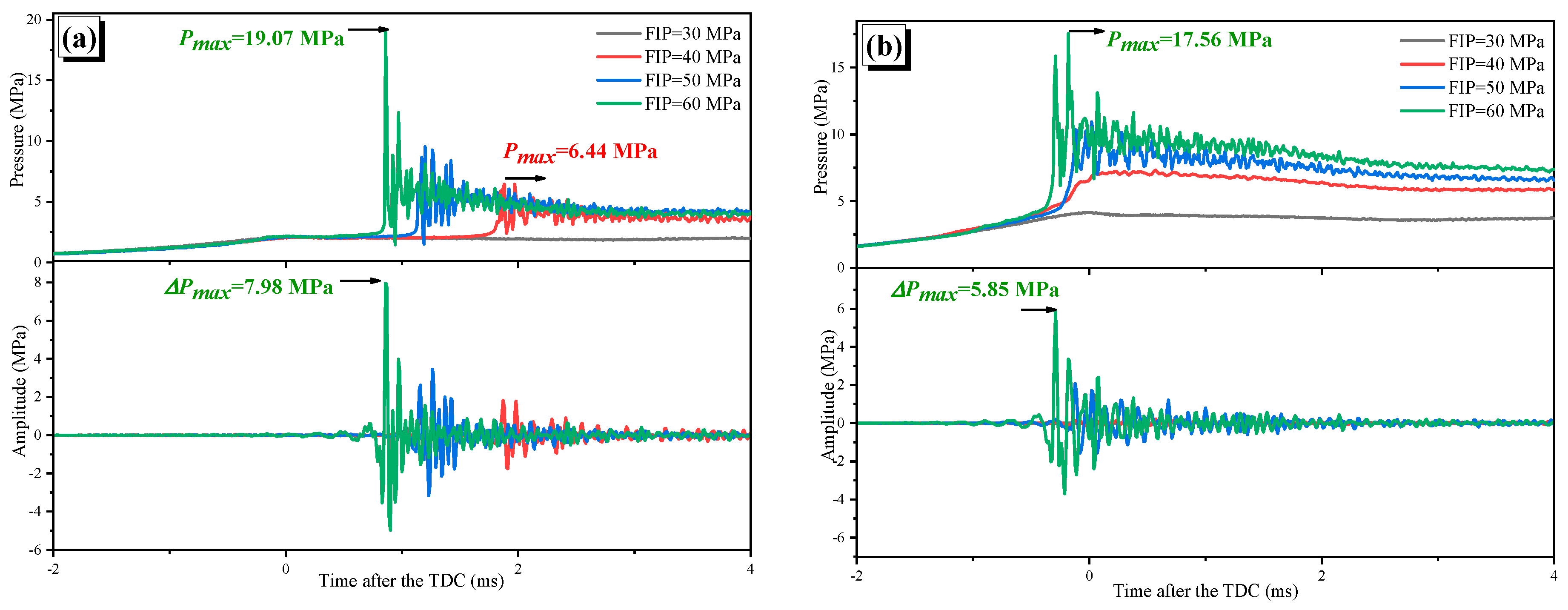
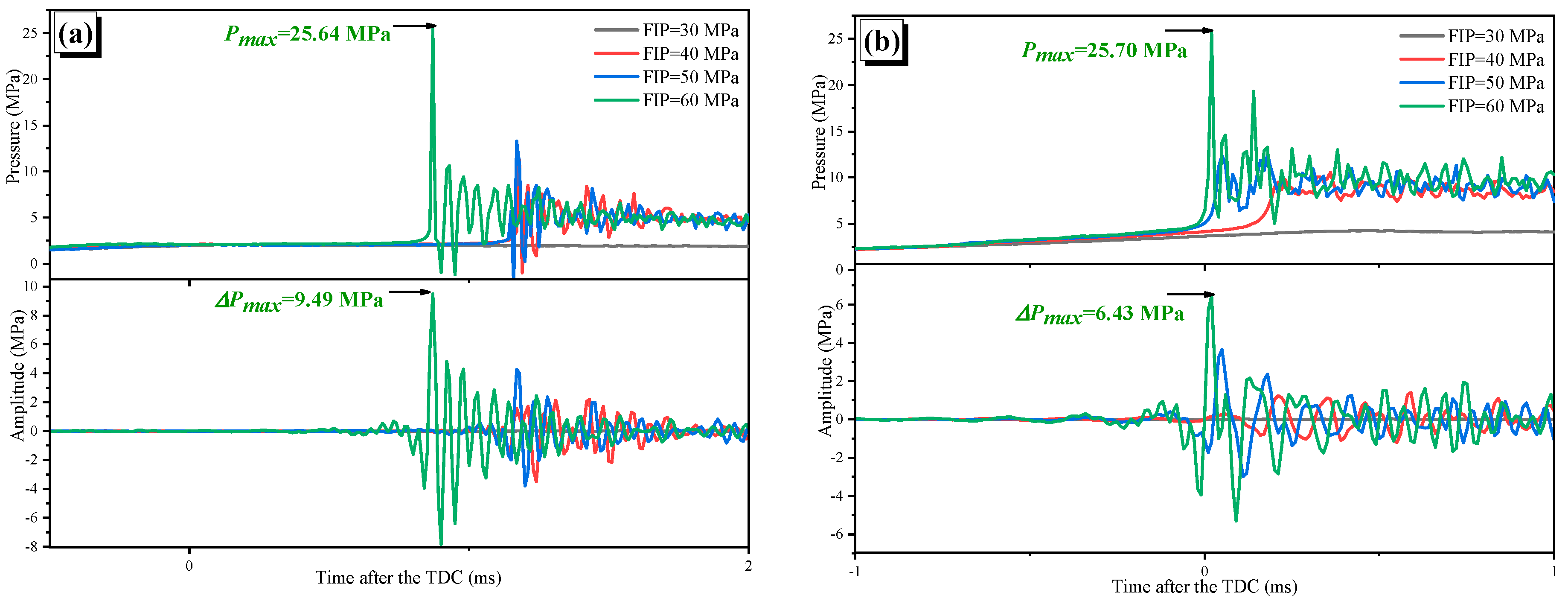
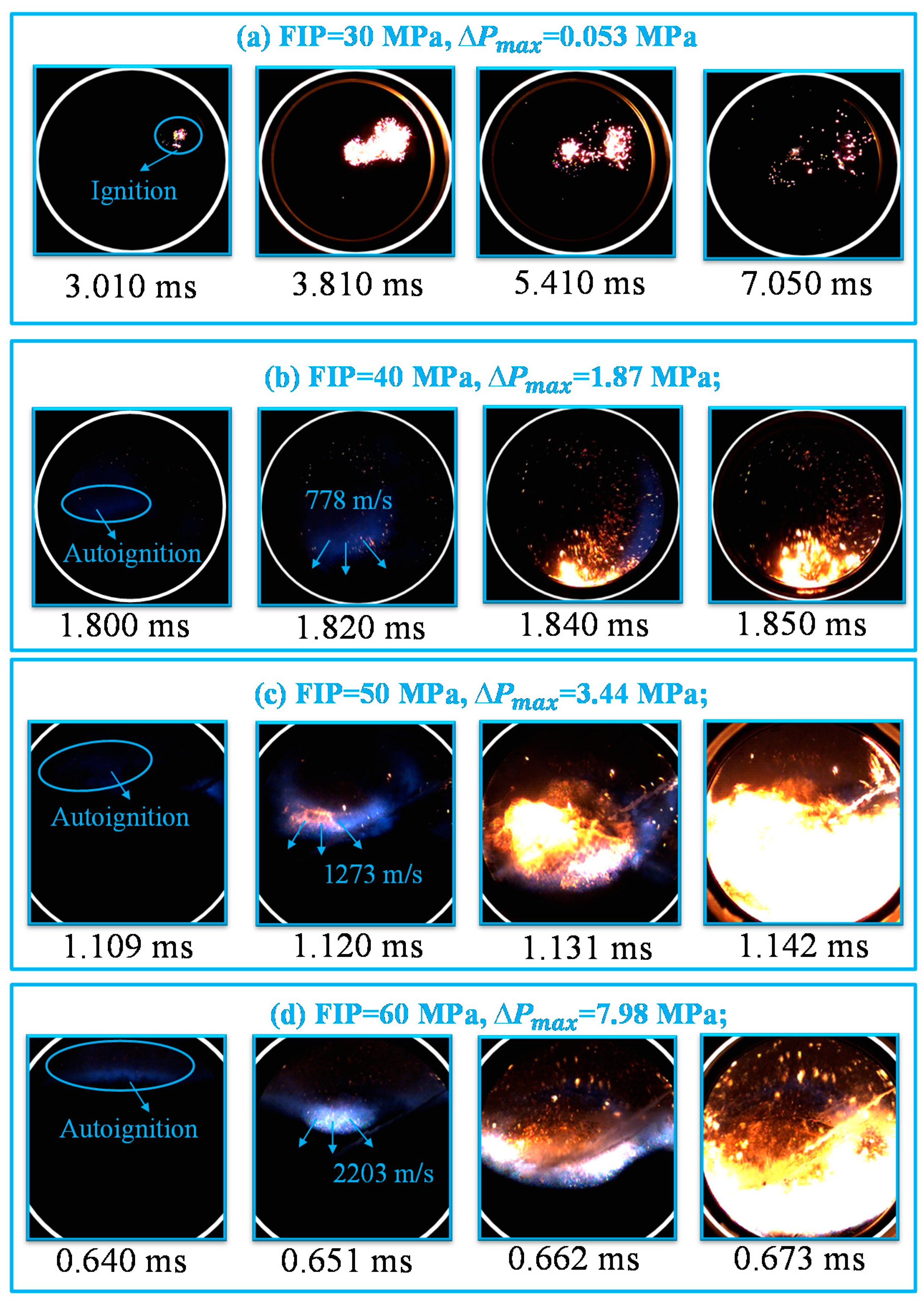
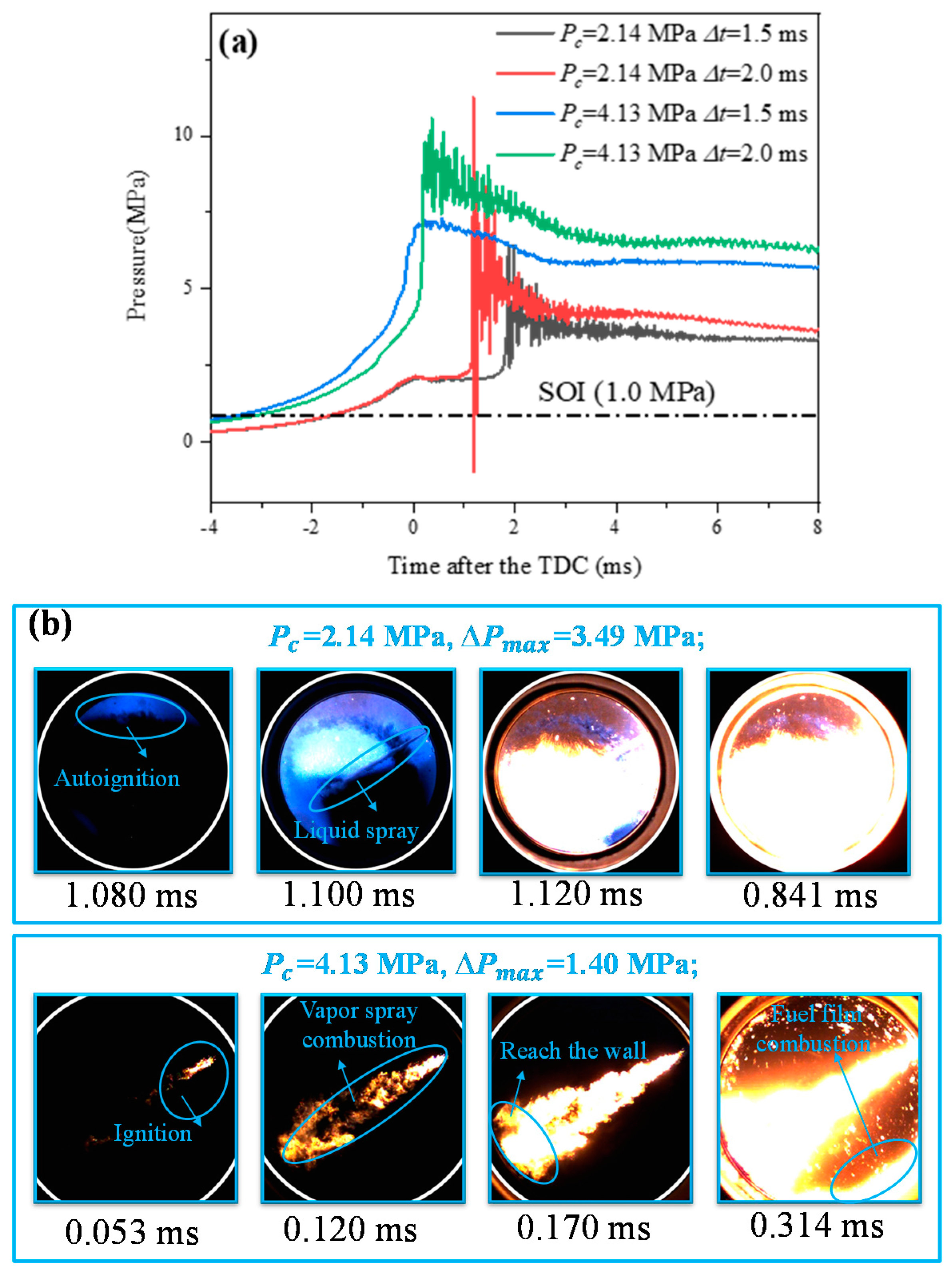
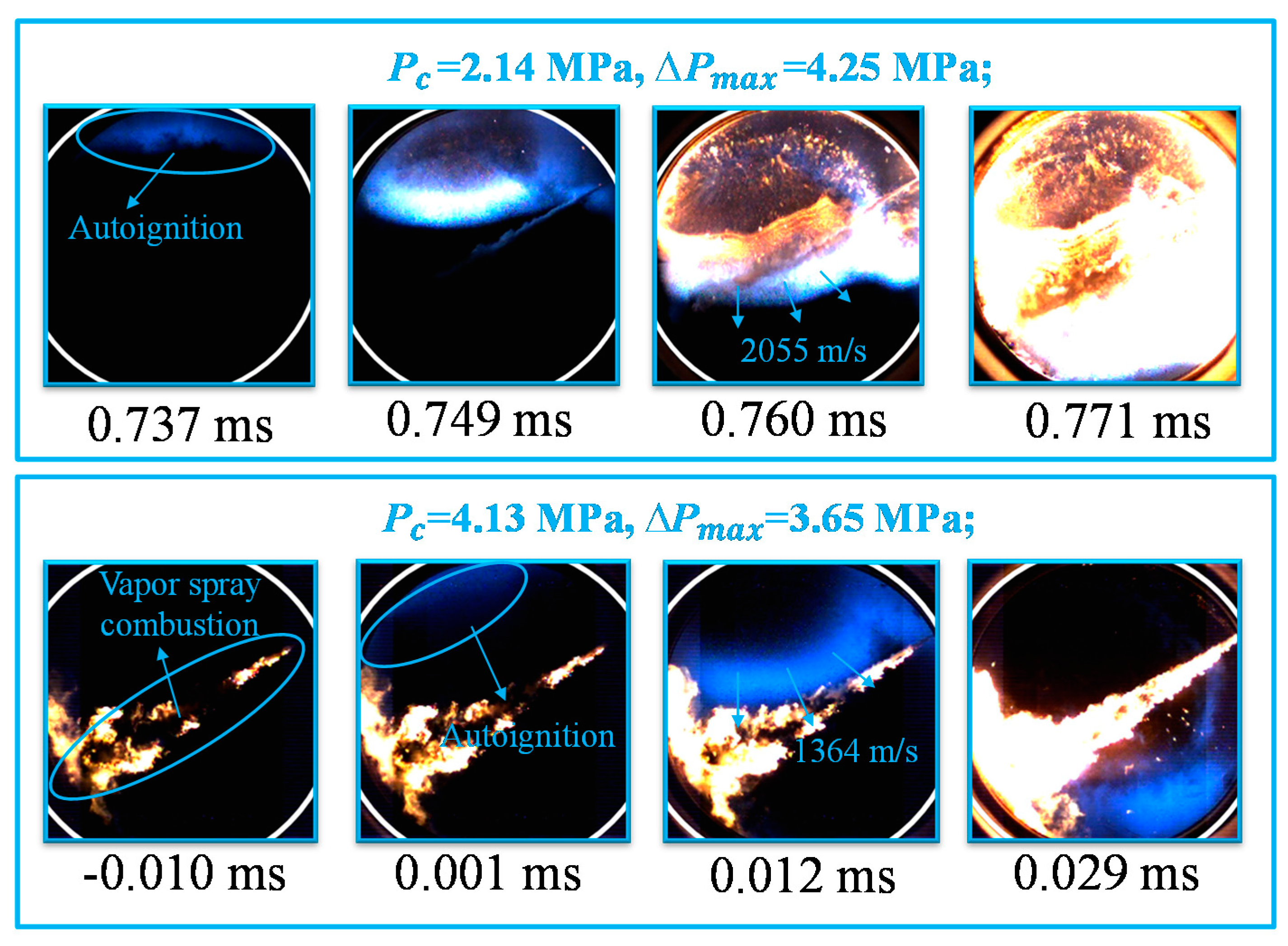
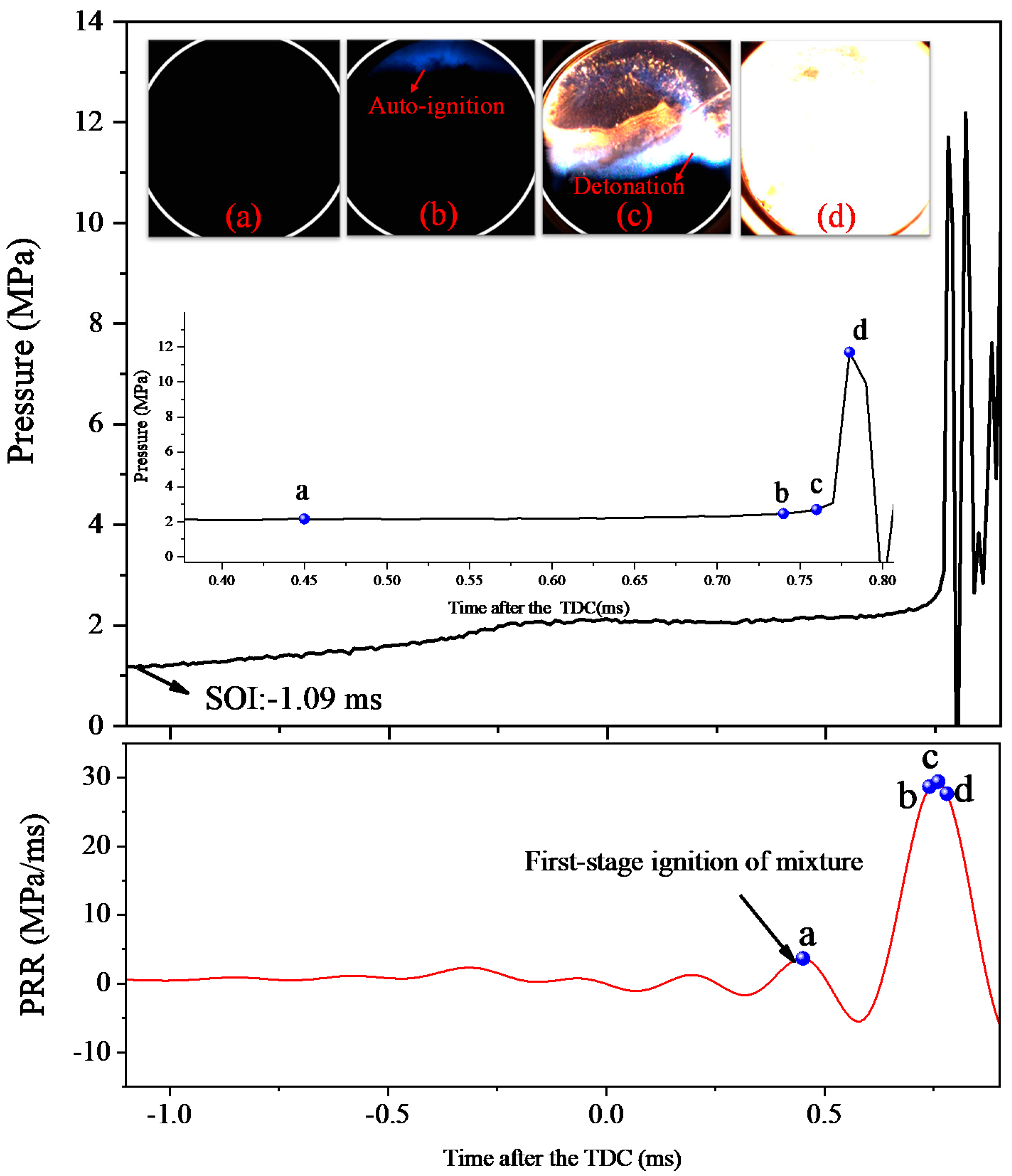
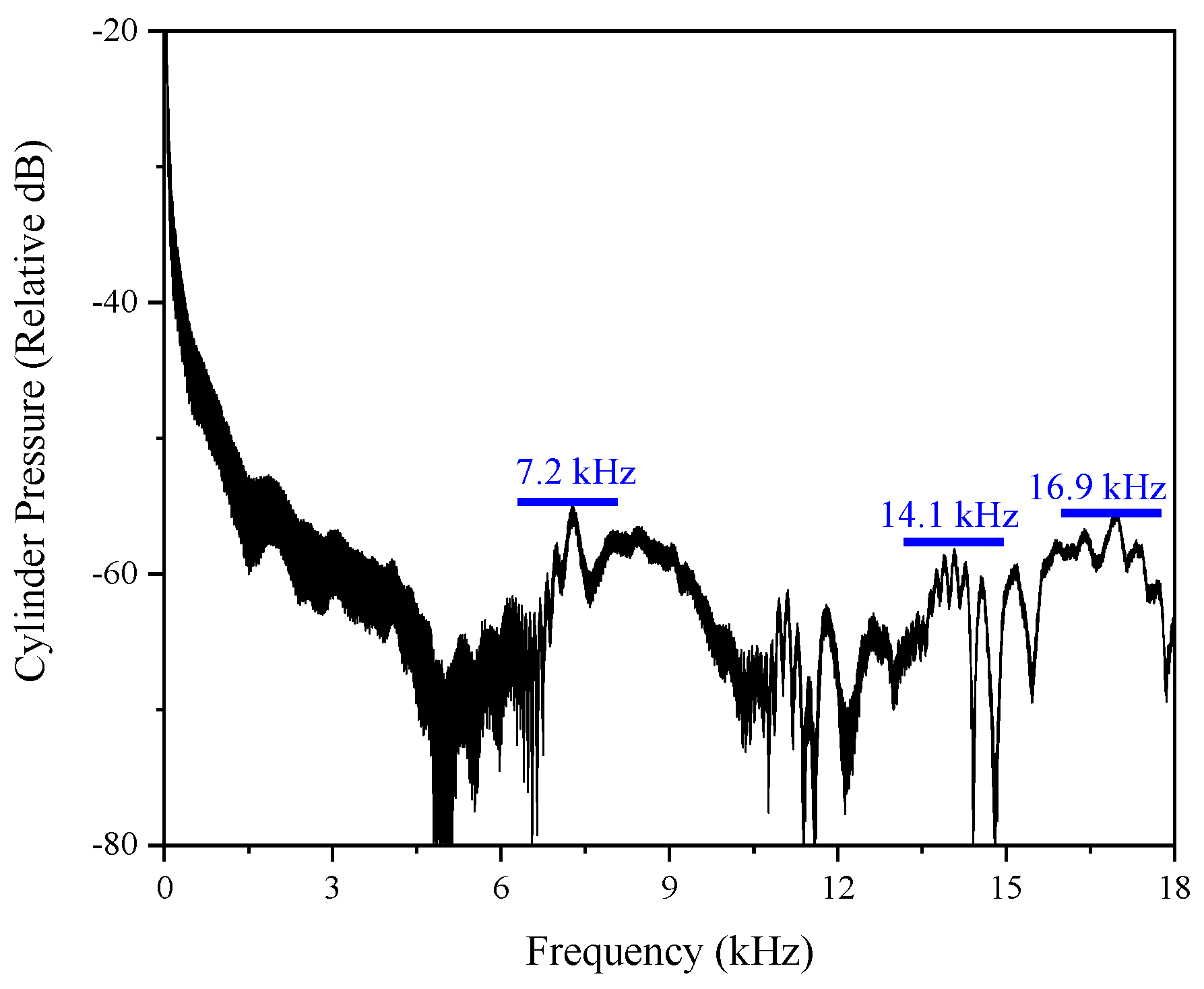
| Diesel Fuel | Straight-Run Diesel |
|---|---|
| Viscosity (mm2/s) at 293 K | 2.344 |
| Cetane number | 42.3 |
| Density (kg/m3) at 293 K | 817.0 |
| Flash point (K) | 335.0 |
| Low heating value (MJ/kg) | 42.84 |
| Distillation of 50% (K) | 518.5 |
| Distillation of 90% (K) | 601.4 |
| D (mm) | FIP (MPa) | ||||||
|---|---|---|---|---|---|---|---|
| 70 | 0.065 | 343 | 2.14 | 930.8 ± 5 | 1.0 | 30–60 | 1.5, 2.0 |
| 70 | 0.130 | 343 | 4.13 | 921.4 ± 5 | 1.0 | 30–60 | 1.5, 2.0 |
© 2020 by the authors. Licensee MDPI, Basel, Switzerland. This article is an open access article distributed under the terms and conditions of the Creative Commons Attribution (CC BY) license (http://creativecommons.org/licenses/by/4.0/).
Share and Cite
Wang, X.; Wei, H.; Pan, J.; Hu, Z.; Zheng, Z.; Pan, M. Analysis of Diesel Knock for High-Altitude Heavy-Duty Engines Using Optical Rapid Compression Machines. Energies 2020, 13, 3080. https://doi.org/10.3390/en13123080
Wang X, Wei H, Pan J, Hu Z, Zheng Z, Pan M. Analysis of Diesel Knock for High-Altitude Heavy-Duty Engines Using Optical Rapid Compression Machines. Energies. 2020; 13(12):3080. https://doi.org/10.3390/en13123080
Chicago/Turabian StyleWang, Xiangting, Haiqiao Wei, Jiaying Pan, Zhen Hu, Zeyuan Zheng, and Mingzhang Pan. 2020. "Analysis of Diesel Knock for High-Altitude Heavy-Duty Engines Using Optical Rapid Compression Machines" Energies 13, no. 12: 3080. https://doi.org/10.3390/en13123080
APA StyleWang, X., Wei, H., Pan, J., Hu, Z., Zheng, Z., & Pan, M. (2020). Analysis of Diesel Knock for High-Altitude Heavy-Duty Engines Using Optical Rapid Compression Machines. Energies, 13(12), 3080. https://doi.org/10.3390/en13123080







